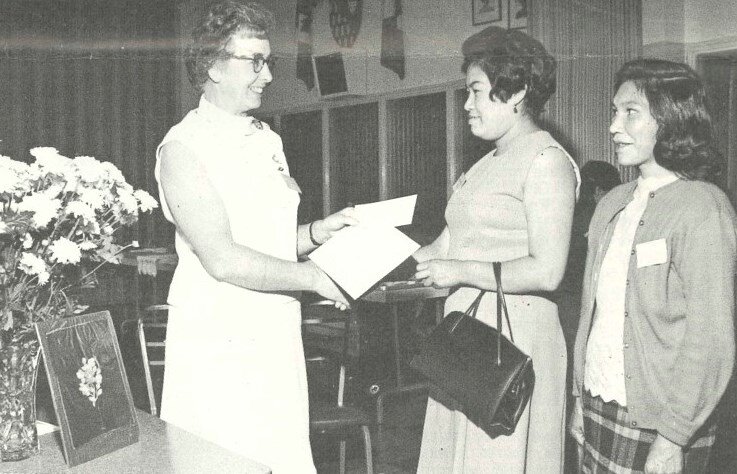Northern Canada Women's Institutes
The material for this column came from the BCWI History Book and past FWIC NewslettersWhen, in 1956, some women in Haines Junction, Yukon, decided to start a Women's Institute because they could related to the Aims and Objectives of the WI, a new era was born. They were affiliated with the British Columbia Women's Institute. The women in the Haines Junction WI were primarily wives of men who worked as police officers, medical personnel and other individuals working there, or women there on their own. But the idea appealed to women in other communities, and soon there were a number of branches in such distance places as: Discovery, Fort Providence, Fort Norman, Tuktoyaktuk, Delta (at Inuvik), Reindeer, Aklavik, Fort MacPherson, Coppermine, Hay River, Yellowknife, Fort Smith and Destruction Bay. The membership of both Reindeer, and Tuktoyaktuk was primarily First Nations women, including Inuit, while others such as Discovery, the roll was made up of wives of miners, and mine executives, public health nurses, teachers and others ho lived in the centre.These Institutes were not often long-lived. When the leaders suddenly moved from the community, the groups sometimes faltered. Others functioned intermittently, following the lifestyle cycle and style of the native people. Finances were also a problem, since they needed to maintain a person who made annual visits to each of the Institutes, and travel in the north was both costly not always easy.With the UNESCO Gift Coupon Plan #367 approved in 1963, the fund raising began. By early 1967 the goal of $20,000.00 was reached. The goals for the expansion of the Women's Institutes in the Canadian Territories was were to help the local people through adult education, to assist in the development of the communities and to spread the sphere of the organization.Many NCWI Branches are planning to enter the Handicraft Competition sponsored by the Associated Country Women of the World, to be held at the time of their twelfth Triennial Conference, Lansing, Michigan, September 3 to 14, 1968.This Triennium the ACWW Needlework Competition has been divided into two sections: Class A , sampler, using traditional stitches, and Class B - “a piece of free needlework using local materials if desired.” This is a new feature of the international competition and was designed to give every constituent society in the more than 40 countries of the world an opportunity to use their own native skills. The moosehair and porcupine quill embroidery, done by the Indian women, are unique to Canada. Entries depicting these crafts from members o the Women's Institutes in the Far North create much interest in this international display. In the Summer 1969 Federated News, a picture showing Canadian Area President of ACWW, Mrs. Matheson presenting an ACWW prize and certificate to Mrs. Bonnetrouge, the craftswoman who made the moosehair embroidery entry for the ACWW conference in Lansing, Michigan. Many members of the Northern Canada WI have attended ACWW and FWIC meetings over the years, and have been very popular with the other attendees. Gladys Vear, a member of Penticton Women's Institute, spent three summers in the Territories travelling, encouraging, organizing and assisting the fledgling Institutes.There was a program offering assistance to communities in the Labrador area – that will be the subject of another column, later in the year.Yours For Home and Country, Ruth Fenner, BCWI Historian
The moosehair and porcupine quill embroidery, done by the Indian women, are unique to Canada. Entries depicting these crafts from members o the Women's Institutes in the Far North create much interest in this international display. In the Summer 1969 Federated News, a picture showing Canadian Area President of ACWW, Mrs. Matheson presenting an ACWW prize and certificate to Mrs. Bonnetrouge, the craftswoman who made the moosehair embroidery entry for the ACWW conference in Lansing, Michigan. Many members of the Northern Canada WI have attended ACWW and FWIC meetings over the years, and have been very popular with the other attendees. Gladys Vear, a member of Penticton Women's Institute, spent three summers in the Territories travelling, encouraging, organizing and assisting the fledgling Institutes.There was a program offering assistance to communities in the Labrador area – that will be the subject of another column, later in the year.Yours For Home and Country, Ruth Fenner, BCWI Historian


